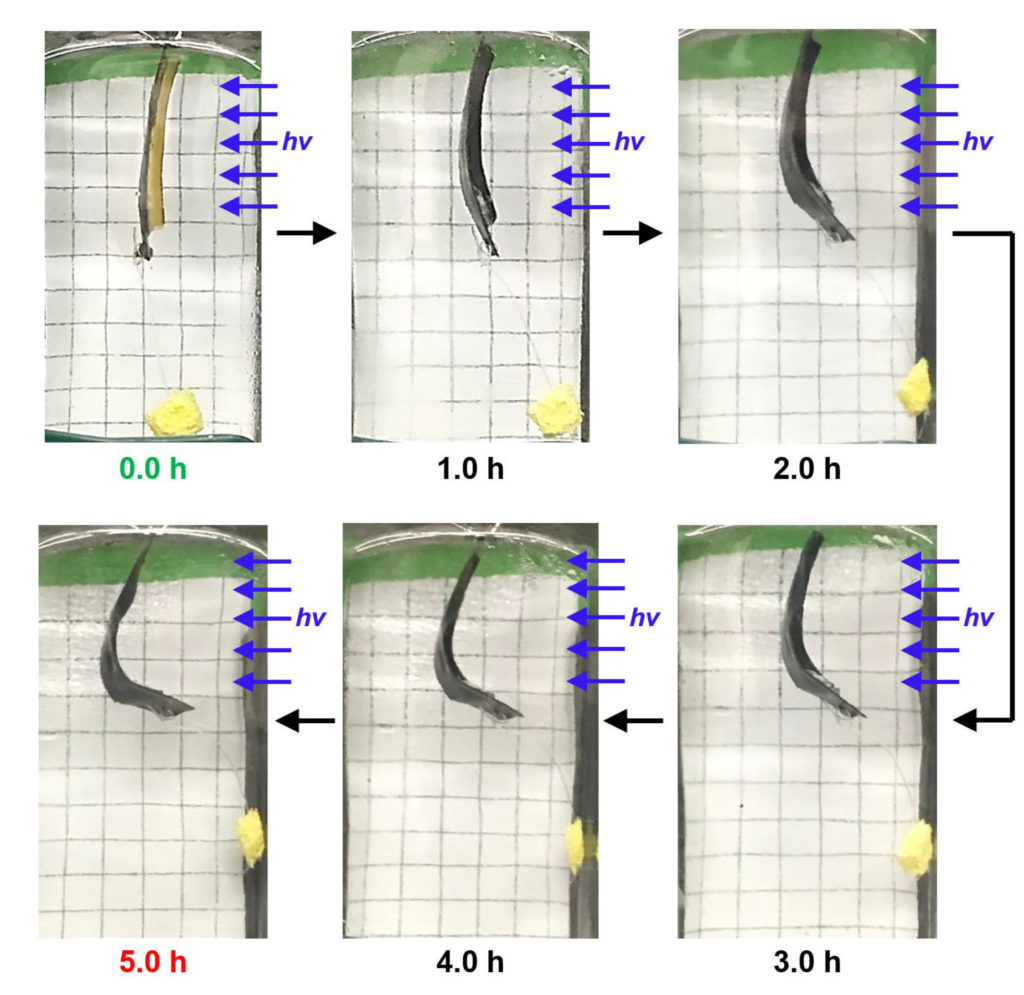
Picture a tiny, makeshift muscle that can curl a 20 milligram suspended weight when exposed to light. Under the right conditions, another mix packs enough power to bench-press a dime.
Researchers at Washington University in St. Louis have created a completely new kind of artificial molecular muscle from a polymer that’s capable of some heavy lifting — relatively speaking.

“The external trigger that initiates the actuation process can be something as simple as sunlight,” said Jonathan Barnes, assistant professor of chemistry in Arts & Sciences and a 2017 Packard Fellow. The novel polymer, which changes color and contracts when exposed to visible light, is described in a Jan. 24 publication of a special issue of Macromolecular Rapid Communications.
Barnes and his team have been working on their proof of concept for the novel redox-responsive polymer — one that contracts when electrons are added (reduction) and expands when they are taken away (oxidation) — since he started at Washington University less than two years ago.
Last fall, they demonstrated that they could successfully build their functional polymer and incorporate it into a pliant, bulk material called a hydrogel. The resulting material could be contracted to one-tenth its original volume and then expanded back to its original size, its long polymer chains delicately folding and unfolding in three dimensions.
The hydrogel contains 5 percent polymer overall, of which only 5 percent is the new, functional polymer; the rest is just water. This means that only 0.25 percent of the total hydrogel is the functional polymer, an incredibly low number in the field.
“If you look at other materials, the active polymer is usually in every link,” said Angelique Greene, a postdoctoral fellow in the Barnes laboratory. “Ours is very dilute, and yet our hydrogels still performed at a comparable and sometimes even better rate.”
Pulling their own weight
But the molecular muscle still needed to be triggered by chemical reduction in a wet solution. To address the slosh factor, the researchers then introduced visible-light-absorbing photoredox catalysts, embedded in the gel, and moved their muscles onto dry ground.
It was time for a strength test.
“We wanted to demonstrate that it could not only change shape, or bend, or turn a different color, but actually do work,” Barnes said.
The researchers affixed their best-performing gel to a piece of black electrical tape, and then attached a small, light piece of aluminum wire holding a small 20 milligram weight on the bottom. They exposed it to a blue light, and, after five hours, the polymer had moved the suspended weight several centimeters from its starting position.

“Here we have a lot fine control,” said Kevin Liles, a PhD candidate in chemistry who co-wrote the new study, along with Greene. “We can irradiate the polymer for a certain amount of time, stop it at a certain number of degrees (of bend), or irradiate a certain portion and get it to contract in certain areas.”
Five hours might seem like a long time to move a few centimeters, but Barnes isn’t worried that Mother Nature does it faster.
“If you’ve ever seen a flower or plant on the side of a mountain, it always bends toward where the light is,” Barnes said. “Nature finds a way to adapt to optimize the amount of light source that hits its petals. This material in principle does the exact same thing.”
The researchers are now looking at how to pair their novel functional polymer with others that are tougher and capable of lifting heavier loads. They also want to figure out how to control the artificial molecular muscles using electrodes. This action would be similar to the way that electrical signals are transmitted in the body, and could pave the way toward future prosthetic applications.
Read more about the published research in Macromolecular Rapid Communications.